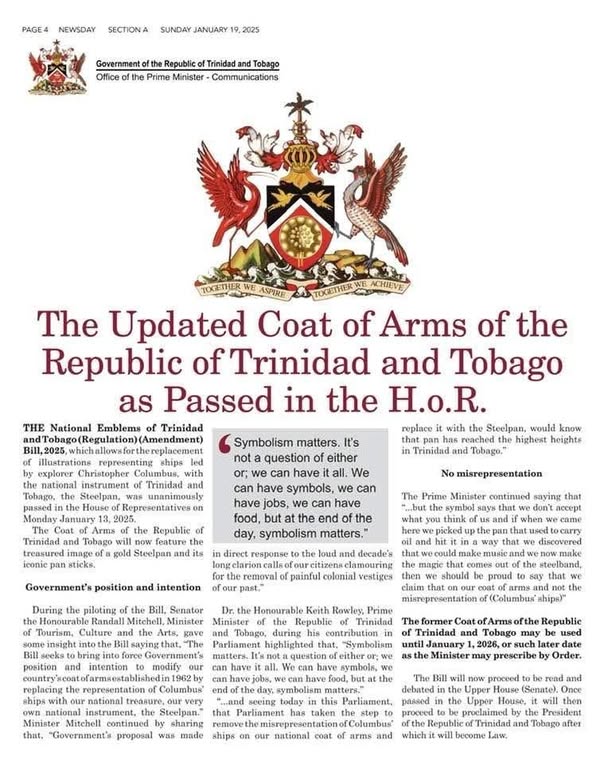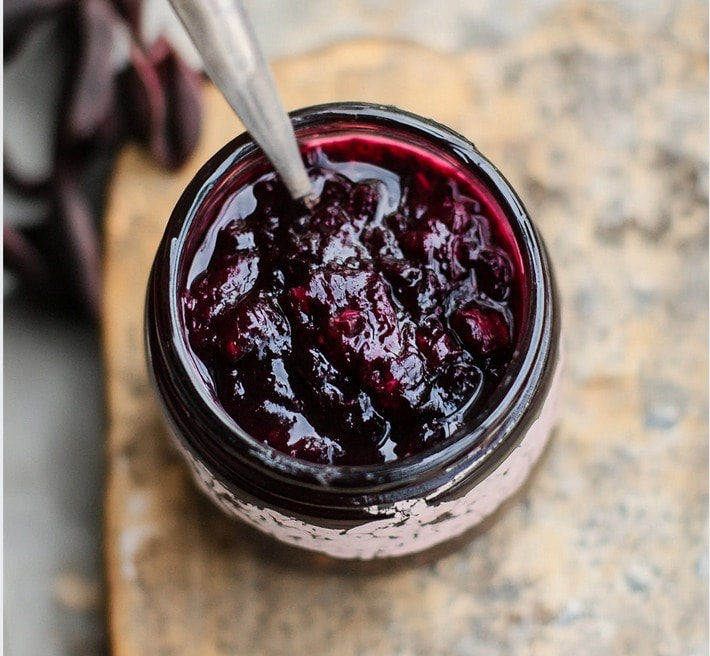|
The existing coat of arms on the financial complext in Port of Spain A design for the new coat of arms has been chosen – it depicts a golden tenor pan and two sticks.
The final version was chosen from among several submissions by artist Gillian Bishop. On January 13, Parliament approved the National Emblems of Trinidad and Tobago (Regulation) (Amendment) Bill, 2025, to give legal effect for the change. The redesign will remove the depiction of the three ships – Nina, Pinta and Santa Maria – used by Italian explorer Christopher Columbus at the base of the coat of arms. ” Pan Trinbago president Beverley Ramsey-Moore said the type of pan used on the coat of arms is a tenor pan with two pan sticks. In a release, Ramsey-Moore hailed the decision as a monumental moment in TT's history. “The inclusion of the steelpan on the national coat of arms is a defining moment for our nation. It symbolises the resilience, ingenuity and unity of our people. Born from struggle, the steelpan has become a beacon of TT’s cultural legacy and innovation. This is a moment for every citizen to stand tall and proud.” During the debate, Tourism, Culture and the Arts Minister Randall Mitchell said the old coat of arms can be used until January 1, 2026, once the act is assented to and proclaimed by the President. Mitchell said the change was made because of public calls to decolonise the symbols of TT. Mitchell said the proposal for the change was formalised by the Cabinet in August 2024. Local jeweller and artist Bishop was asked to develop the new design. “After a thorough review and thoughtful consideration of all designs, the Pan Trinbago team is pleased to express our enthusiastic agreement with design number seven. We are particularly heartened that this design features the steelpan alongside its iconic two-pan sticks. This inclusion celebrates the steelpan’s role as the national musical instrument of TT, symbolising the creativity and indomitable spirit of our people,” Mitchell said, quoting from a Pan Trinbago letter. Mitchell said the transitional period will be until January 1, 2026, which meant there would be no great or disruptive urgency to change the old coat of arms. “There will be no mad scramble. There will be no need for citizens to desperately line up at government offices to replace the old coat of arms. In a case where the coat of arms is in digital forms and online, it can be replaced in documents such as official correspondence and other paraphernalia with immediate effect, easily and at minimal cost." “Where the coat of arms is in the form of physical installations, eg on government buildings, the bill provides for a period of transition, where all government agencies can now plan and budget in the upcoming appropriation bill, in the upcoming months, for changes that will need to be put in place by January 1, 2026.” Moruga/Tableland MP Michelle Benjamin said the opposition was only informed about the bill at 2.40 pm on January 10, and told that it would be added to the Order Paper on January 13. The Opposition was only given additional information about the bill at 4 pm on January 13. “I apologise to the members of Pan Trinbago present in the gallery as the members on this side were invested in the state of emergency debate. I apologise that pan is not being treated in the way it should be treated,” she said, noting the unpreparedness of the Opposition for the debate. "How does the issue before us today improve the lives of our people? How does it address the struggles of our pan players who continue to fight for survival in a system that overlooks their existence? Symbolism cannot replace substance. “Pan players are only celebrated during the Carnival season. The government could have come here today and itemised how they intend to improve the lack of institutional support.” Benjamin asked for a definitive cost of changing the coat of arms. She said the country was left in limbo as there was not a final date given for the changeover of ID cards and other documents. The Prime Minister said the government could not count on the support of the opposition even in such a unifying matter. “Any MP saying they needed extended notice to be able to decide whether they will support the modernisation of our emblem could not be serious, especially since this issue has been around since last August (2024) and to come and say you were ambushed and therefore have nothing useful to say is really not a serious contribution.” He said over the years the government had come to realise symbols and symbolism matter and the steelpan represents all of TT. Rowley said steelpan players were honoured outside of Carnival and were embodiments of the country’s watchwords of discipline, tolerance and production. Opposition Leader Kamla Persad-Bissessar asked when the bill would be proclaimed. She called for the coat of arms in the House of Representatives to be changed first. She said the opposition supported the change. “I want to place on record that we fully support this amended bill. It is long in coming but the day has come and we welcome that day.” This story was originally published with the title "National Emblems Bill passed" and has been adjusted to include additional details. See original post below. THE National Emblems of Trinidad and Tobago (Regulation) (Amendment) Bill, 2025, was passed in the Parliament on January 13. Tourism, Culture and the Arts Minister Randall Mitchell said the old coat of arms can be used until January 1, 2026, once the act is assented to and proclaimed by the President. Speaking during debate on the bill late on Monday night, Mitchell said the bill amends Part I of the schedule to the National Emblems of TT (Regulation) Act. “This clause amends the description of the coat of arms of TT by deleting the reference in the base of the arms to ‘three ships of the period of Christopher Columbus also gold the sails set proper’ and substituting that the base of the coat of arms will now contain ‘a gold steelpan and its iconic two pan sticks, also gold.’” Mitchell said the proposal for the change was formalised in August 2024 by cabinet, which agreed jeweller and artist Gillian Bishop would be engaged to develop the new design. He said she was asked to prepare renderings of the coat of arms to be considered by the cabinet and taken to Parliament. He said the consideration and endorsement of Pan Trinbago was sought on the design and received in November 2024. Mitchell said the transitional period will last until January 1, 2026, which meant there would be no great or disruptive urgency to change the old coat of arms to the new one. Pan Trinbago president Beverley Ramsey-Moore hailed the decision as a monumental moment in TT's history.. “The inclusion of the steelpan on the national coat of arms is a defining moment for our nation. It symbolises the resilience, ingenuity and unity of our people. Born from struggle, the steelpan has become a beacon of TT’s cultural legacy and innovation. This is a moment for every citizen to stand tall and proud,” she said in a news release on January 14. (Source: Newsday, January 15, 2025)
0 Comments
Trinidad and Tobago jazz trumpeter Etienne Charles has been nominated for a NAACP Image Award.
In a statement, a representative for the artist said Charles has been nominated in the Outstanding Jazz Album category for his album Creole Orchestra. Other nominees in the category are Samara Joy, Matthew Whitaker, Kirk Whalum and Javon Jackson and Nikki Giovanni. This is the first time Charles has received a solo nomination for the NAACP Image Award. Charles, a Trinidadian musician who weaves historical and cultural stories into his compositions, has been making waves since Creole Orchestra launched in June 2024. The album spent seven weeks atop the Jazzweek charts and was named the number one album of their top 100 for 2024. “I feel humbled, grateful, elated, excited, flabbergasted and so blessed. It was an honour and privilege to have the amazing Rene Marie alongside my stellar band of musicians in studio and on stage for this project. Big thanks to all of you for trusting me with your time and talents. It was another joy to see the album’s reception worldwide with colossal support from radio and press. To the listeners, programmers and writers, thank you,” said Charles upon receiving the news. Long hailed for his work as a trumpeter, composer, and improviser, as well as for his deep knowledge of rhythms from his native Trinidad and Tobago and around the Eastern Caribbean, Charles has mostly worked with small combos over his nearly 20-year career. Released in the United States in June and in Europe in September, Creole Orchestra features 22 musicians strongwith vocals from two-time Grammy Award Nominee Rene Marie who is featured on four of the 13 tracks, including “I Wanna Be Evil,” Eartha Kitt’s theme song, as well as the jazz standard “Centrepiece” and two of her originals. Rapper Brandon Rose and turntablist DJ Logic appear together on Bell Biv Devoe’s new jack swing hit “Poison” connecting Charles’s arrangement with the song’s hip-hop roots. Lead trumpeter Jumaane Smith and trombonist Michael Dease both give standout performances on Monty Alexander’s reggae-spiced “Think Twice”; bassist Ben Williams wows with his soulful improv on the hard-swinging “Night Train”; while Charles, alto saxophonist Godwin Louis, and pianist Sullivan Fortner illuminate the leader’s calypso “Douens.” Charles has many accolades. In 2024 he was conferred the title Chevalier de l’Ordre des Arts et des Lettres by the French Ministry of Culture. In 2012, he was written up in the US Congressional Record for his musical contributions to Trinidad and Tobago and the World, in 2013 he received the Caribbean Heritage Trailblazer award from the Institute of Caribbean Studies (Washington, DC) and in 2015 became a Guggenheim Fellow. In 2016 he was the recipient of the Michigan State University Teacher Scholar Award and the Jazz at Lincoln Center Millennial Swing award. He made his debut as producer and songwriter on the album Petite Afrique by Somi (Sony/Okeh 2017) which won Outstanding Jazz Album at the 2018 NAACP Image Awards and he has been featured as a bandleader at the Newport Jazz Festival (RI), Monterey Jazz Festival (CA), Atlanta Jazz Festival (GA), Pittsburgh JazzLive international Festival (PA), San Jose Jazz Festival (CA), Java Jazz Festival (Indonesia), Ottawa Jazz Festival (Canada), St. Lucia Jazz Festival, Barbados Jazz Festival, Library of Congress (DC), Carnegie Hall (NY) and Koerner Hall (Canada). As an educator and conductor, he has done residencies at the Juilliard School, Stanford University, Columbia College Chicago, Oakland University, Kent State University, Walnut Hills High School, Cultural Academy for Excellence, and the US Military Academy. Charles currently serves as Professor of Studio Music and Jazz at the University of Miami, Patricia L. Frost School of Music. In 2013, his album Creole Soul reached number one for three weeks on the Jazzweek chart and was eventually named number three Jazz Album of the year by Jazzweek. Charles also recently appeared with soca icon Machel Montano on NPR Music's Tiny Desk stage. Upcoming Tour Dates Jan 17-18 Mendelssohn Theatre, (Earth Tones) Ann Arbor, MI Jan 31st MOCA, North Miami, FL Feb 4 Gusman Concert Hall, Coral Gables, FL (Frost Studio Jazz Band) Feb 6 Road March in Concert II, Queen’s Hall, St. Ann’s, Port of Spain, TT Feb 8 St. George Jazz Festival, St. George, UT Feb 13 - Kravis Center, West Palm Beach, FL Feb 15 - Jazz Houston Gala (Rene Marie’s Jump in he Line) Houston, TX March 3 Riddim Brass & Mas presents FOLKLORE Live Carnival Monday, Woodbrook, TT March 15 SFJAZZ Center, San Francisco, CA March 21-23 Cincinnati Pops with Marcus Roberts, Cincinnati, OH April 2 National Sawdust Gala, Brooklyn, NY April 3 NIU School of Music, DeKalb, IL April 4 Side Door, Old Lyme, CT April 5 Amherst Jazz Festival, Amherst, MA April 12, Princeton University, NJ April 19 Armbrister Park, Coconut Grove, Miami, FL . (Source: The Loop, Jan 13, 2025) We’re thrilled to announce that Trinidad Remains, directed by Karen Martinez and produced by Natasha Dack-Ojumu and Lisa Wickham, will kick off 2025 in spectacular fashion as the Opening Night film at the prestigious British Shorts Film Festival in Berlin on January 23, 2025!
This UK-TT collaboration, starring Leonie Elliott, Syntyche Bishop, and Kevon Brooks, has been lauded for its moving storytelling and vibrant performances, blending universal themes with a unique Caribbean perspective. A true cinematic gem, Trinidad Remains has already won Best Comedy at Caribbean Tales Toronto and Best Short Film (Narrative) at TTFF. Now, it’s set to take Berlin by storm! (Source: The Trinidad and Tobago Film Company, Feb 8m 2025)  Cassava Coconut Cake by this bagogirl
Ingredients 1 (2-pound) bag of grated cassava 1 (12-ounce) can evaporated milk 1 (14-ounce) can condensed milk 1 (13.5-ounce) can coconut milk ¾ cup (150g) granulated sugar ¼ cup (113g) grated cheddar cheese ½ cup (35g) coconut flakes (optional) 2 large eggs, beaten 2 ounces (56g) unsalted butter, melted ½ teaspoon (1g) grated nutmeg 1 teaspoon vanilla extract ½ cup (35g) toasted coconut flakes (optional) Instructions Preheat your oven to 350°F (180°C). Grease and flour a 9"x13" baking dish, then set it aside. In a large mixing bowl, combine the grated cassava, evaporated milk, coconut milk, and ⅔ of the condensed milk (reserve the remaining ⅓ for later). Stir until well blended. Add the grated cheddar cheese, beaten eggs, melted butter, vanilla extract, ½ cup coconut flakes (if using), and grated nutmeg to the mixture. Mix thoroughly to combine all the ingredients. Pour the mixture into the prepared baking dish, spreading it evenly. Bake in the preheated oven for about 40 minutes. After 40 minutes, remove the dish from the oven. Spread the reserved ⅓ can of condensed milk over the top of the cake, then sprinkle with toasted coconut flakes (if using). Return the dish to the oven and bake for an additional 5-10 minutes, or until the top is golden and set. Once done, remove the cake from the oven and let it cool for about 10 minutes. Slice and serve. Enjoy! (Source: Tropical recipiesCaribbean Cuisine and Recipes, Jan 8 2025) SIX Trinidadians have been announced among the 2025 Cohort of the Young Leaders of the Americas Initiative (YLAI) fellowship programme. In a news release on January 8, the US embassy said the TT cohort includes Dominick Alexander, Naomi Anderson, Dharnel Duprey, Desirai Johnson-Phillip, Shereesa Khan and Simon Neptune Dharnel Dariel Duprey. - Photos courtesy US Embassy SIX Trinidadians have been announced among the 2025 Cohort of the Young Leaders of the Americas Initiative (YLAI) fellowship programme. In a news release on January 8, the US embassy said the TT cohort includes Dominick Alexander, Naomi Anderson, Dharnel Duprey, Desirai Johnson-Phillip, Shereesa Khan and Simon Neptune. Shereesa Khan. The US Department of State’s YLAI is a programme that promotes entrepreneurship and economic prosperity across the Western Hemisphere, connecting entrepreneurs across borders through an annual fellowship programme, it said. It will benefit 280 entrepreneurs from 37 countries.. The release said 2025 marks ten years of the YLAI programme.  Simon Neptune The six from Trinidad and Tobago will join young leaders from countries in Latin America, the Caribbean and Canada for the hybrid fellowship, which was launched on December 9, 2024. The programme, the release said, starts with a virtual entrepreneurial leadership curriculum this month. Fellows will then travel to cities across the US in May for a four-week professional placement with a host organisation. The programme concludes in June with all fellows attending a closing forum in Washington, DC. Naomi Anderson. The embassy said since YLAI’s launch in 2015, more than 1,750 fellows have built connections with over 1,250 US businesses and organisations. The 2025 cohort, it added, will bring the number of TT fellows to 44. After completing the programme, fellows use the strategies they learned to attract new resources to their business and improve operations. YLAI promotes US business models, increases trade, encourages job creation, and builds lasting and sustainable networks of young entrepreneurs and business and social leaders across Latin America, the Caribbean, Canada and the US, the release said. The 2025 young leaders: Dominick Alexander, business: Alexander works in the music sector as the CEO of Laudem Music School. The school provides music education for students of all ages and abilities. Dominick Alexander Naomi Anderson, business: Anderson works in the food and beverage sector as the owner and head pastry chef of Unicakery. The company creates custom cakes and desserts. Dharnel Dariel Duprey, environment: Duprey is the founder and operations manager of Growing Essentials Agricultural Supplies and Services. The organisation focuses on sustainable agriculture, including hydroponics and beekeeping. Desirai Johnson-Phillip, environment: Johnson-Phillip is the founder and CEO of Leading Seedling and Exotic Plants. The company provides seedlings, plants, and agricultural services and is focused on engaging a new generation of agricultural leaders by attracting and empowering youth in the field. Desirai Johnson-Phillip. Shereesa Khan, business: Khan works in the beauty business sector as the founder and CEO of Vortex Sensations. The manufacturing company creates organic products for people with skin and hair issues.
Simon Neptune, environment: Neptune works in the energy sector as the founder of Neptune Biosystems. The company is focused on developing biorefineries that convert landfill waste into carbon-neutral diesel fuel. (Source: Newsday Jan 10, 2025)  PM-IN-WAITING: Energy Minister and Minister in the Office of the Prime Minister Stuart Young, seen leaving the Red House on October 14, has been selected by the PNM's Lower House caucus to be the Prime Minister when incumbent Dr Keith Rowley demits that office. - File photo by Ayanna Kinsale THREE days after revealing his intention to step down as Prime Minister, Dr Rowley announced on January 6 that Minister of Energy and Minister in the Office of the Prime Minister Stuart Young will replace him as head of the government.
Speaking to reporters during a news conference at the close of the government’s two-day parliamentary retreat at the Tobago Plantations, Magdalena Grand Beach & Golf Resort, Lowlands, Tobago, Rowley said deciding on his replacement as prime minister, and the way forward for the People's National Movement (PNM), were some of the main items on the agenda over the past two days. He said Young, who has served in various capacities as a government minister over the past ten years, received the majority of support from the party’s parliamentary caucus. “Once a vacancy arises with respect to the appointment of a prime minister, it falls to the President to respond to that by making an appointment on the person, who, in the President’s view, commands the majority in the House,” Rowley said, adding the provisions are contained in Section 76 of the Constitution. “So we, as a caucus, as a PNM in the house (of Representatives), we discussed at length and in the end, we came up with a situation where the entire PNM caucus is in support of Member of Parliament Stuart Young, MP for Port of Spain North/St Ann’s West. And we are very pleased to announce that the promise of a smooth transition is going according to plan.” Rowley said the PNM was a very stable and democratic organisation. “In this case, the President would be guided by the expectation of the caucus and there would be no discrepancy between what the President thinks as against what others may think as to who has the majority of support in the House.” Responding to his appointment in a post of his Facebook page, Young, who turns 50 on February 9, thanked his parliamentary colleagues for the confidence expressed in him. He also thanked Rowley for his “continued and exemplary leadership in guiding through this historic process.” ROWLEY CONFIDENT Young said he was proud to be a member of the PNM and looks forward to working tirelessly “not only with all of our members but also with all citizens...as we continue working towards the building of our country and ensuring its future success.” During the news conference, Rowley said apart from Young, Minister of Planning and Development and Arima MP Pennelope Beckles-Robinson had also thrown her hat into the ring, but did not get the majority support. There was speculation that PNM general secretary and Minister of Youth Development and National Service Foster Cummings might also have been in the running. Rowley declined to say how many parliamentarians voted for Young but expressed confidence in his ability to lead the government. “Minister Young has been in the government for about ten years, operating first out of the Office of the Prime Minister, where he would have seen the government close up and would have participated in the government. I have seen him at work on many very detailed and technical assignments and he has not only done the job, but has distinguished himself. “I have worked very closely with Minister Young, and while many other members of the Cabinet could also have been considered, I have no doubt that Minister Young’s experience, dedication and commitment...will ensure that during the period that he has the responsibility for being prime minister, he will continue to put the people's interest first, and his competence and experience will allow us to get the best from an officer in that position.” Rowley, who served two terms as prime minister, said he expects Young to step into that position soon. He said he has several obligations to fulfil, one being the Caricom meeting in Barbados on February 19. That meeting is to be chaired by Barbados Prime Minister Mia Mottley. That meeting, he said, will be his last. Rowley said he also has to complete matters involving several Caricom sub-committees, which he chairs. “Sometime after that I will be able to indicate the actual time I will leave." Rowley said he also has several domestic matters to wrap up. “I don’t want to walk away and leave things that I could do easily for somebody else to do with more difficulty. So I am pretty much wrapping up those matters.” At a news conference in Tobago on January 3, Rowley also announced that he would not offer himself as a nominee for the Diego Martin West seat, which he has represented in the House of Representatives since 1991. He also intends to step down as PNM political leader. Asked about the process, Rowley said, “The political leader matter comes up with respect to a convention, because once the resignation is effected, that is a matter involving the President on an appointment in the context of the majority in the Parliament. “So while we did have some senators here who are ministers, they would not be part of the process, because that is a Lower House matter for elected members.” OTHER PNM BUSINESS AT HAND He said a convention is likely to be held on September 28. Rowley, who turns 76 on October 24, said he has no regrets about quitting politics after 45 years in public life. “I think that I used my time in a useful way. I have not been always successful in everything I embarked on. But I think by and large, I would like to believe I was able to contribute not only to my life, so that my children could have a country that they could be proud and can have an opportunity to be good citizens, but every other child from every other family. “So from that standpoint, though there were times when I felt that it was difficult, it was stressful, I always persevered, because I know it was for the benefit of the wider national good. “If you ask me if I was making a decision today (January 6) as to whether I would go into politics to become a minister or an MP or prime minister, I will tell you a different thing. That is a different story, because I didn’t start today.” Rowley said he joined the PNM in 1974. “At that time, I had a different perspective. I didn’t have a family. I had time on my hand. I had age on my side. “But I want to see as I leave that public life is viewed as honourable and something in which young people can be encouraged to get involved in, rather than be scared away by this constant stream of hatred, bile and vitriol which some people seem to think must be the portion, once you come into public life. “Because if that continues to be the way we treat it, and the population buys into the nastiness that people just put out and say that is politics, then good people will stay away from it. And if good people stay away, only a certain kind of people will rush in, and then that is what you will get as your leadership and your management, because there will never be a time when there is no government in this country. We will always get people wanting to be there.” In the meantime, Rowley said the party’s general secretary has also been guided to open nominations for the two Port of Spain seats and the three Diego Martin seats. He added the party also has opened nominations for the D’Abadie/O’Meara constituency, left vacant after the death of MP and Minister in the Ministry of Education Lisa Morris-Julian. Morris-Julian, her son Jesiah, six, and her daughter Xianne, 25, died in a fire at their Farfan Street, Arima home on December 16. Rowley said the party is preparing for the upcoming general election. “We are moving steadily ahead to take part in the election that is due sometime this year and the PNM would be very ready, notwithstanding the fact that I am not offering myself in Diego Martin West.” He said he had spoken to officials in his constituency “and they are quite happy that they are in a position to ensure that there is no hiccup in Diego Martin West.” (Source: Newsday, January 7, 2025) At just 27 years old, Joshua Regrello has etched his name in history and hearts by attempting to set a Guinness World Records, for the Longest Marathon Playing Steelpan, surpassing an awe-inspiring 30 hours. This remarkable feat, filled with resilience, passion, and national pride, brought tears of joy to many as he carried the soul of Trinidad and Tobago in every note. Earlier this year, Joshua also made history as the first pannist to perform at the Great Wall of China, showcasing our culture on a global stage. Joshua’s journey is a testament to the power of determination and the magic of the steelpan—a symbol of our identity. (Source: Life in Trinidad, Dec 28, 2024). Watch interview with Joshua below. A vibrant and tangy Sorrel Jam made from fresh sorrel petals, perfect for spreading on toast, pastries, or as a topping for desserts! Ingredients: 2 cups fresh sorrel petals, rinsed and dried (about 200 grams) 2 cups water 1 ½ cups granulated sugar (adjust to taste) 1 tablespoon lemon juice 1 cinnamon stick (optional, for a hint of warmth) 1 teaspoon grated ginger (optional, for added flavor) Instructions: 1. Prepare Sorrel: Place the sorrel petals in a pot and add 2 cups of water. Bring to a gentle boil, then reduce the heat and simmer for about 10 minutes until the petals soften and the liquid becomes dark and vibrant. 2. Blend and Strain: Remove the pot from heat and let it cool slightly. Blend the mixture until smooth, then strain it through a fine sieve to remove any solids, creating a smooth sorrel puree. 3. Make the Jam: Return the strained sorrel mixture to the pot. Add the sugar, lemon juice, cinnamon stick, and ginger (if using). Stir well to combine. 4. Cook Until Thickened: Place the pot over medium heat and bring to a simmer, stirring occasionally to prevent sticking. Continue to cook for 20-30 minutes, or until the mixture has thickened to a jam-like consistency. You’ll know it’s ready when it coats the back of a spoon and holds shape when cooled. 5. Cool and Store: Remove from heat, let it cool, and discard the cinnamon stick. Pour the jam into sterilized jars, leaving a little space at the top, then seal tightly. Tips & Notes: Test for Thickness: Place a small amount of jam on a chilled plate. If it holds shape after a few seconds, it’s ready! Adjust Sweetness: If the jam tastes too tart, add a bit more sugar, 1 tablespoon at a time, until it reaches your desired sweetness. Storage: Store in the refrigerator for up to 3 weeks, or process in a water bath for longer storage. Enjoy this delicious Sorrel Jam on toast, scones, or as a unique topping for desserts! (Source: Mini Flavour, December 8, 2024) |
T&T news blogThe intent of this blog is to bring some news from home and other fun items. If you enjoy what you read, please leave us a comment.. Archives
April 2025
Categories
All
|











 RSS Feed
RSS Feed